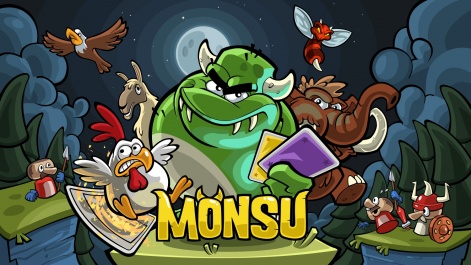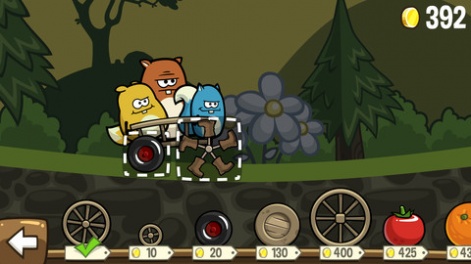It was back in April 2012 that 'Boomlagoon' – the ridiculously catchy name for a new Finnish studio set up by, as we put it at the time, “Rovio maestros Antti Stén and Tuomas Erikoinen” - first hit the pages of PocketGamer.biz.
The studio's first title, Noble Nutlings, launched the following January, and then....well, things went a little quiet.
Our pages weren't troubled by the studio's exploding logo again until May this year, when Boomlagoon lifted the lid on a funding injection of $3.6 million, with the first fruits of that cash – the firm's part card collector, part side-scroller Monsu – having hit the App Store this week.
Talking to Boomlagoon's CMO Olli Laesvirta just days before Monsu's debut at Pocket Gamer Connects in Helsinki, we wanted to know how the studio had changed in the intervening two years, how it sees the Finnish dev scene overall and, most importantly, why it's banking on Monsu to make significant waves in mobile in 2014.
Pocket Gamer: In the press release for Monsu, it's described as 'side-scrolling collectable card game'. How do those two genres combine in play?
Olli Laesvirta: We're really into this character kind of thing – that's something that we feel we have a pretty good thing going on.
In Monsu, you start out with just Monsu, the main character, and once you start to progress through the level the backstory of the evil villagers living nearby who steal his treasure plays out, and he goes on a rampage to get it back.
The player collects in-game currency, completes missions, competes in tournaments with friends and things like that, and once he progresses he starts to get enough coins and money that he can use to buy different times of card packs.

So, we have three different levels of card packs – lucky packs, which are kind of like common cards, then dare packs that have something special and then we have epic packs that are really, really epic. Obviously. [Laughs]
There are always people who don't like F2P, but I don't think Finns are afraid of the model.Olli Laesvirta
So you can purchase the card packs with the in game currency and all of these reveal new characters tothe game. Once you progress, you get quite a lot of distinct characters in the game that you can take with you. For example, wings that make Monsu fly, and a chicken that destroys everything – he doesn't know how to fly, so he just falls down on everything [Laughs]. The dynamics of the gameplay really change.
Are there stages you can only get through if you use the right cards, or does it just change the experience?
So, you can pick up those different card packs throughout the game – that's kind of the progress mechanism, more or less – and then can just mix and match different card types from my collection. There's a permanent collection of cards for me, and I can also upgrade the cards to get more special powers that the card holds.
The idea is that there a little bit more than just power ups or upgrades to the main character – they're actually like new guys that bring something new to the game.
The design of all these characters has been a big thing for Boomlagoon, hasn't it?
Yeah, exactly. So that's what we've been focusing on, trying to really build a strong backstory for the game and strong backstory for Monsu himself - where he got the treasure.

We kind of had a cool shared vision from all of the team as to how the game looks, how should the different levels fit in the game and things like.
And why has character design been so crucial?
I guess what we're trying to achieve with focusing on the characters and really focusing on the world is that the game mechanics and characters – the whole package, really – it feels complete, polished and somehow easy to understand for the user.
I guess we were afraid – well, not necessarily “afraid” - but we were trying to make it so that there's a clear red line throughout the game and the user is like “yeah, I get that, that's cool.”
So it's essentially a good way to communicate with the player then?
Yeah, exactly, exactly.
It's been around a year and a half since your first release Noble Nutlings – what did you learn from that experience?
A lot of things. Back then, it was only the founding three guys who made that initial guys – a lot of the guys coming from Rovio background. I guess the thinking was still pretty heavily on the premium side of things.
If you think about Noble Nutlings, it's a pretty game, the characters are really cute and the physics mechanisms and everything works pretty well, but I guess the free-to-play business model was not really as far as it could have been at that point.

So that's something that we really learned throughout that experience and also we co-operated with LINE with that title, and LINE is social platform – a messenger platform with things like social play, competing with friends, having colloboration parts to the game. Things like that. So we learned about social aspects that make it more meaningful for the user, and a lot of those learnings you can see in Monsu.
Also, we have a lot more depth in the graphics, the thinking behind the characters and the free-to-play mechanics.
What do you make of this claim that the Finnish in general are more comfortable with free-to-play as a mechanic than people in other regions, such as the UK?
Of course there are always people who don't like free-to-play, but I don't think we're that afraid of the model - I think we look at it really as an opportunity.
Development is a lot about opportunities, and the funding makes things a lot easier.Olli Laesvirta
I think, for example, with Monsu we're really generous with the content, so you can easily grind...well, not easily, but you can grind the game ,and you can have a lot of fun in the game without spending any money. I think that's the central idea behind free-to-play and why it makes it natural for us.
It's kind of a cool feeling when you design the game first, play it by yourself and as a development team, and then you start getting to the point yourself where at some point in the game experience you're like “why can't I buy more energy?” or “why can't I get the mighty Mammoth?” or some other character you're really looking forward to get. You kind of think “okay, this makes a lot of sense – I can grind some more and get those later, or I can do it now if I really want it.”
From that perspective, free-to-play is pretty cool.
You guys yourself had a big injection of cash recently – how's that been deployed? Where's the money been spent?
Well, we haven't used it all yet. [Laughs] We've grown. I think this year alone we've added six people to the team, so we're now 10 people altogether.
So we've got stronger on the business side, but especially on the development side, so we can have bigger or more efficient production teams and do obvciously a lot more things, but we're not in any kind of hurry to have explosive head count growth or anything like that.
We really want to...well, not take it slow, but be careful selecting the right kind of people that come into the company and that really kind of hold the style of games we want to make. But of course, development is a lot about opportunities – [the funding] makes things a lot easier.
Thanks to Olli for his time.




















